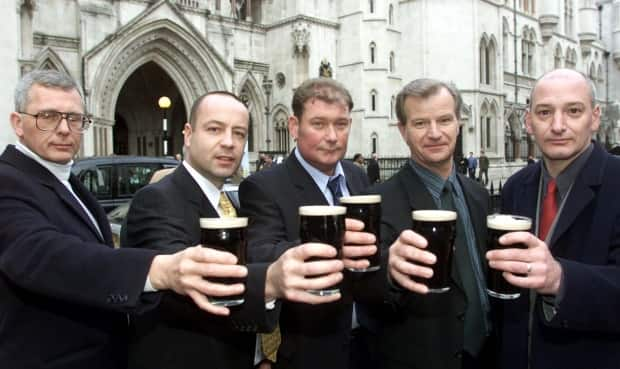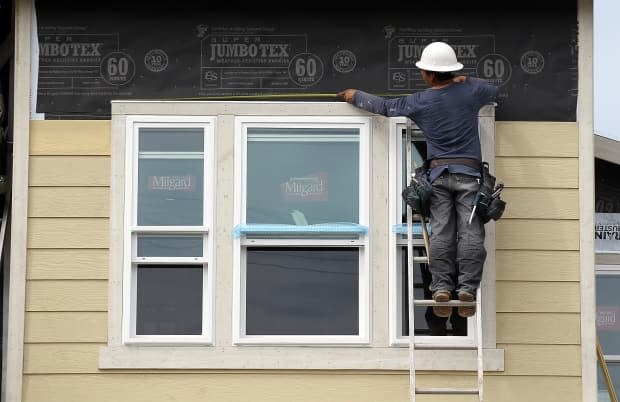As the U.K. brings back imperial measurements, is it time for Canada to drop them?

For more than 50 years, Canada's dual system for measuring things has been a source of confusion for tradespeople, crafters, newcomers and anyone who's ever been asked for their weight in kilos.
Why, for instance, are outdoor temperatures measured in Celsius — until you get into a pool? Why do we order our morning coffee in ounces but buy milk in litres?
Canada is officially a "metric" country, yet many industries and individuals work in imperial measurements, adding extra costs and complexity for businesses and making everyday tasks — from buying produce to ordering a drink — just a little more complicated.
Soon, Canada may have a new ally in mixing its measurements: British Prime Minister Boris Johnson is reportedly planning to announce the revival of the imperial system for the Queen's Jubilee. The move will allow stores to sell products in pounds and ounces, as well as grams — further distancing the U.K. from Europe, which uses the metric system.
"It's plain crazy," said Prof. Werner Antweiler, an economist at the Sauder School of Business at the University of British Columbia, of the U.K.'s proposed change.
"This is just plain populism. It has absolutely nothing to do with economics. It's detrimental to the economy. It's detrimental to the commercial interests of Britain, because most of their trade is still in the European Union, like it or not."

The U.S., Myanmar and Liberia are the only countries that still use the imperial system day to day, though the U.S. system has some slight differences.
Antweiler and others — including some who work entirely in the imperial system — say Canada should go the opposite route from the U.K., by ditching the imperial system and going fully metric, like most of its trading partners.
Canada's continued use of both systems, Antweiler said, adds "an additional layer of complexity and additional source of error and an additional source of cost, because now you have to comply to the other standard."
But greater metrication would require buy-in across industries, from engineering and real estate to farming and beer-brewing — and it could create new headaches for Canadian businesses with clients across the southern border.
When Canada went metric
To understand why most Canadians know their height in feet and inches but measure their travel plans in kilometres, you have to go back to 1970. That's when the federal government launched the Metric Commission to convert Canada from imperial to metric, and to educate the public on how to use the new system.

In 1975, weather broadcasts switched from Fahrenheit to Celsius. Food packaging and street signs were soon amended to metric units, and by 1979, gas stations were filling tanks by the litre instead of in gallons.
For many industries, though, the change was voluntary. Amid pushback from them, as well as some members of the public, and from the United States — which abandoned its own metrification plans in the early 1980s — Canada became stuck in measurement limbo by the time the Metric Commission was abolished in 1985.
WATCH | In 1985, Canadians were still confused about the metric system:
Today, entire industries — like construction and other trades — still operate in the imperial system, or a mix of the two, requiring a level of bilingualism in two systems of measurement.
The accuracy argument
Like most tradespeople, Toronto cabinet-maker Greg Moogk works almost exclusively in the imperial system — except for when an architect gives him metric drawings, as sometimes happens with high-rise construction projects, or when he's buying products from outside of North America.
"It's way, way, way easier to be more accurate in the metric system," Moogk said, adding that he's received requests like "'just cut it at a hair over 1/16 of an inch' — like I have an idea of what that is."
"If we had the option of just all of a sudden eliminating the imperial system, it obviously would be weird for a minute, because everyone [in the trades] would have to learn the metric system. But it's so much easier [to use] — it's a lot more difficult for someone to get their head around fractional math than really easy decimal places, right?"
Other creators face similar challenges working between the two systems.
"The tools that we use in quilt-making [are] all in imperial measurements … But in Canada, when we go to buy the fabric, we're buying it in metres, not yards," said Karen Neary, a quilt pattern designer from Amherst, N.S.
She includes both systems of measurement on her patterns, so clients can figure out how much fabric they need — no matter where in the world they are.

"Metric is much easier, because if somebody says 'five-eighths of a yard' or whatever, you've got to stop and think, well, what is that?" she said.
"But I really cannot see us switching over to metric completely, because all the tools, all my rulers, are quarter-inch, everything is quarter-inch."
Those measurements get even more confusing when you consider beer, which is measured differently depending on if you're buying it in a can or from a tap. A tall can contains 473 ml (the equivalent of 16oz, or a U.S. pint), but walk up to a bar and order a pint, and you'll get 20 oz (an imperial pint).
For those in the beer industry, switching between those measurements is "like second nature," said Kyra Dietsch, marketing manager at Muskoka Brewery in Bracebridge, Ont.
"We walk a line between the two, and we end up using them so interchangeably that we don't even notice … When I'm going into a restaurant, I'm ordering in ounces; when I'm looking at the cans, I refer to them as millilitres. So it really depends on the format as well."
Time for a change?
Switching between the two is easier in some industries than others. It could be as simple as swapping ounces for millilitres on a coffee shop menu, labelling lumber in centimetres or printing Celsius measurements on oven knobs.
"I'd say 80 per cent of the history of metrification is just the willingness to actually put different labels on things, and basically nudge people toward using the international standard," Antweiler said.

But some industries would need to take extra steps, like retraining workers such as engineers and architects, and companies might need to change their manufacturing lines or other operations to adapt, depending which countries their clients are in.
Antweiler believes a total shift would only be possible if the federal government mandated it — and that's unlikely to happen.
In a statement to CBC News, a spokesperson for Innovation, Science and Economic Development Canada said the government "supports and encourages the use of metric units, but understands that some Canadians are more comfortable with the imperial system. Therefore, the use of both systems of measurement is permitted in commerce."
For all the confusion in the Canadian measuring system, it's a source of hope for those who can only dream of living in a country where things are measured in metres and litres — like Don Hillger, president of the U.S. Metric Association, which has been running into resistance for more than 100 years while pushing for the U.S. to adopt the metric system.
"I even have relatives that say, 'Please don't do this, don't promote [metrication]' until they die, because they don't want to learn metric," Hillger said.

He says he hears from a lot of younger people who think it's "ridiculous that the United States is the major holdout." But it's unclear when — or if — his country might join the rest of the world in going metric.
"You've got to have more people ask for it before it'll actually take place in the States. And I don't think we're quite at that point," he said. But he added: "I think it would help if Canada changed."


